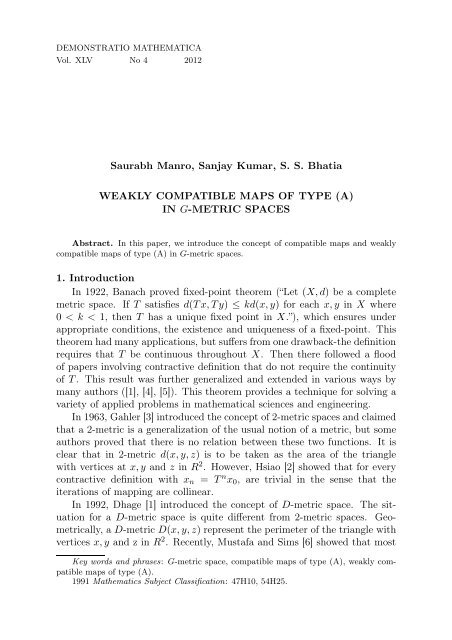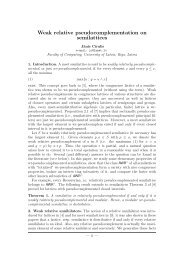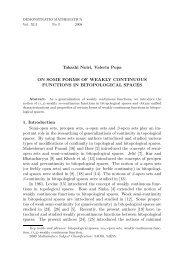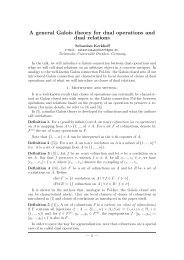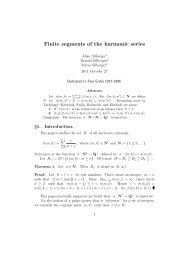(A) IN G-METRIC SPACES 1. Introduction In 1922, Banach
(A) IN G-METRIC SPACES 1. Introduction In 1922, Banach
(A) IN G-METRIC SPACES 1. Introduction In 1922, Banach
Create successful ePaper yourself
Turn your PDF publications into a flip-book with our unique Google optimized e-Paper software.
DEMONSTRATIO MATHEMATICA<br />
Vol. XLV No 4 2012<br />
Saurabh Manro, Sanjay Kumar, S. S. Bhatia<br />
WEAKLY COMPATIBLE MAPS OF TYPE (A)<br />
<strong>IN</strong> G-<strong>METRIC</strong> <strong>SPACES</strong><br />
Abstract. <strong>In</strong> this paper, we introduce the concept of compatible maps and weakly<br />
compatible maps of type (A) in G-metric spaces.<br />
<strong>1.</strong> <strong><strong>In</strong>troduction</strong><br />
<strong>In</strong> <strong>1922</strong>, <strong>Banach</strong> proved fixed-point theorem (“Let (X,d) be a complete<br />
metric space. If T satisfies d(Tx,Ty) ≤ kd(x,y) for each x,y in X where<br />
0 < k < 1, then T has a unique fixed point in X.”), which ensures under<br />
appropriate conditions, the existence and uniqueness of a fixed-point. This<br />
theorem had many applications, but suffers from one drawback-the definition<br />
requires that T be continuous throughout X. Then there followed a flood<br />
of papers involving contractive definition that do not require the continuity<br />
of T. This result was further generalized and extended in various ways by<br />
many authors ([1], [4], [5]). This theorem provides a technique for solving a<br />
variety of applied problems in mathematical sciences and engineering.<br />
<strong>In</strong> 1963, Gahler [3] introduced the concept of 2-metric spaces and claimed<br />
that a 2-metric is a generalization of the usual notion of a metric, but some<br />
authors proved that there is no relation between these two functions. It is<br />
clear that in 2-metric d(x,y,z) is to be taken as the area of the triangle<br />
with vertices at x,y and z in R 2 . However, Hsiao [2] showed that for every<br />
contractive definition with xn = T n x0, are trivial in the sense that the<br />
iterations of mapping are collinear.<br />
<strong>In</strong> 1992, Dhage [1] introduced the concept of D-metric space. The situation<br />
for a D-metric space is quite different from 2-metric spaces. Geometrically,<br />
a D-metric D(x,y,z) represent the perimeter of the triangle with<br />
vertices x,y and z in R 2 . Recently, Mustafa and Sims [6] showed that most<br />
Key words and phrases: G-metric space, compatible maps of type (A), weakly compatible<br />
maps of type (A).<br />
1991 Mathematics Subject Classification: 47H10, 54H25.
902 S. Manro, S. Kumar, S. S. Bhatia<br />
of the results concerning Dhage’s D-metric spaces are invalid. Therefore,<br />
they introduced a improved version of the generalized metric space structure,<br />
which they called it as G-metric spaces. For more details on G-metric<br />
spaces, one can referred to the papers [7]–[13].<br />
Now we give preliminaries and basic definitions which are used throughout<br />
the paper.<br />
<strong>In</strong> 2006, Mustafa and Sims [7] introduced the concept of G-metric spaces<br />
as follows:<br />
Definition <strong>1.</strong><strong>1.</strong> [7] Let X be a nonempty set, and let G : X ×X ×X →<br />
R + be a function satisfying the following axioms:<br />
(G1) G(x,y,z) = 0 if x = y = z,<br />
(G2) 0 < G(x,x,y), for all x,y ∈ X with x �= y,<br />
(G3) G(x,x,y) ≤ G(x,y,z), for all x,y,z ∈ X with z �= y,<br />
(G4) G(x,y,z) = G(x,z,y) = G(y,z,x) = ··· (symmetry in all three variables)<br />
(G5) G(x,y,z) ≤ G(x,a,a) + G(a,y,z) for all x,y,z,a ∈ X, (rectangle<br />
inequality)<br />
then the function G is called a generalized metric, or, more specifically a<br />
G-metric on X and the pair (X,G) is called a G-metric space.<br />
Definition <strong>1.</strong>2. [7] Let (X,G) be a G-metric space, and let {xn} be<br />
a sequence of points in X, a point x in X is said to be the limit of the<br />
sequence {xn} if lim<br />
m,n→∞ G(x,xn,xm) = 0 and one says that sequence {xn}<br />
is G-convergent to x. Thus, that if xn → x or lim<br />
n→∞ xn → x as n → ∞ in a<br />
G-metric space (X,G) then for each ǫ > 0, there exists a positive integer N<br />
such that G(x,xn,xm) < ǫ for all m,n ≥ N.<br />
Now we state some results from the papers ([7]–[9]) which are helpful for<br />
proving our main results.<br />
Proposition <strong>1.</strong><strong>1.</strong>[7] Let (X,G) be a G-metric space. Then the following<br />
are equivalent:<br />
(1) {xn} is G-convergent to x,<br />
(2) G(xn,xn,x) → 0 as n → ∞,<br />
(3) G(xn,x,x) → 0 as n → ∞,<br />
(4) G(xm,xn,x) → 0 as m,n → ∞.<br />
Definition <strong>1.</strong>3. [7] Let (X,G) be a G-metric space. A sequence {xn}<br />
is called G-Cauchy if, for each ǫ > 0 there exists a positive integer N such<br />
that G(xn,xm,xl) < ǫ for all n,m,l ≥ N; i.e. if G(xn,xm,x1) → 0 as<br />
n,m,l → N.
Weakly Compatible maps of type (A) in G-metric spaces 903<br />
Proposition <strong>1.</strong>2. [7] If (X,G) is a G-metric space then the following are<br />
equivalent:<br />
(1) The sequence {xn} is G-Cauchy,<br />
(2) for each ǫ > 0 , there exist a positive integer N such that G(xn,xm,xm) <<br />
ǫ for all n,m ≥ N.<br />
Proposition <strong>1.</strong>3. [7] Let (X,G) be a G-metric space. Then the function<br />
G(x,y,z) is jointly continuous in all three of its variables.<br />
Definition <strong>1.</strong>4. [7] A G-metric space (X,G) is called a symmetric Gmetric<br />
space if G(x,y,y) = G(y,x,x) for all x,y in X.<br />
Proposition <strong>1.</strong>4. [7] Every G-metric space (X,G) will defines a metric<br />
space (X, dG) by<br />
(i) dG(x,y) = G(x,y,y)+G(y,x,x) for all x,y in X.<br />
If (X,G) is a symmetric G-metric space, then<br />
(ii) dG(x,y) = 2G(x,y,y) for all x,y in X.<br />
However,if (X, G) is not symmetric, then it follows from the G-metric properties<br />
that<br />
(iii) 3/2G(x,y,y) ≤ dG(x,y) ≤ 3G(x,y,y) for all x,y in X.<br />
Definition <strong>1.</strong>5. [7] A G-metric space (X,G) is said to be G-complete if<br />
every G-Cauchy sequence in (X,G) is G-convergent in X.<br />
Proposition <strong>1.</strong>5. [7] A G-metric space (X,G) is G-complete if and only<br />
if (X,dG) is a complete metric space.<br />
Proposition <strong>1.</strong>6. [7] Let (X,G) be a G-metric space. Then, for any<br />
x,y,z,a in X it follows that:<br />
(i) If G(x,y,z) = 0, then x = y = z,<br />
(ii) G(x,y,z) ≤ G(x,x,y)+G(x,x,z),<br />
(iii) G(x,y,y) ≤ 2G(y,x,x),<br />
(iv) G(x,y,z) ≤ G(x,a,z)+G(a,y,z),<br />
(v) G(x,y,z) ≤ 2<br />
3 (G(x,y,a)+G(x,a,z)+G(a,y,z)),<br />
(vi) G(x,y,z) ≤ (G(x,a,a)+G(y,a,a)+G(z,a,a)).<br />
Definition <strong>1.</strong>6. [7] Let (X,G) and (X 0 ,G 0 ) be G-metric spaces and f<br />
:(X,G) → (X 0 ,G 0 ) be a function, then f is said to be G-continuous at a<br />
point a ∈ X if and only if, given ǫ > 0 there exists δ > 0 such that x,y<br />
in X and G(a,x,y) < δ implies G 0 (f(a),f(x),f(y)) < ǫ. A function f is<br />
G-continuous at X if and only if it is G-continuous at all a ∈ X .
904 S. Manro, S. Kumar, S. S. Bhatia<br />
2. Main results<br />
<strong>In</strong> 1998, Jungck and Rhoades [5] introduced the concept of weakly compatibility<br />
as follows:<br />
Definition 2.<strong>1.</strong> [5] Let (X,G) be a G-metric space, f and g be self maps<br />
on X. A point x in X is called a coincidence point of f and g iff fx = gx.<br />
<strong>In</strong> this case, w = fx = gx is called a point of coincidence of f and g.<br />
Definition 2.2. [5] Two self-mappings S and T are said to be weakly<br />
compatible if they commute at coincidence points.<br />
We introduce following definitions:<br />
Definition 2.3. Let S and T be maps from a G-metric space (X,G) into<br />
itself. The maps S and T are said to be compatible map if<br />
lim<br />
n→∞ G(STxn,TSxn,TSxn) = 0 or lim<br />
n→∞ G(TSxn,STxn,STxn) = 0<br />
whenever {xn} is sequence in X such that lim<br />
n→∞ Sxn = lim<br />
n→∞ Txn = t for<br />
some t in X.<br />
Definition 2.4. Let S and T be maps from a G-metric space (X,G) into<br />
itself. The maps S and T are said to be compatible map of type (A) if<br />
lim<br />
n→∞ G(TSxn,SSxn,SSxn) = 0 and lim<br />
n→∞ G(STxn,TTxn,TTxn) = 0<br />
whenever {xn} is sequence in X such that lim<br />
n→∞ S{xn} = lim<br />
n→∞ Txn = t for<br />
some t in X.<br />
Definition 2.5. Let S and T be maps from a G-metric space (X,G)<br />
into itself. The maps S and T are said to be weakly compatible of type (A)<br />
if<br />
and<br />
lim<br />
n→∞ G(TSxn,SSxn,SSxn) ≤ lim<br />
n→∞ G(STxn,SSxn,SSxn)<br />
lim<br />
n→∞ G(STxn,TTxn,TTxn) ≤ lim<br />
n→∞ G(TSxn,TTxn,TTxn)<br />
whenever {xn} is sequence in X such that lim<br />
n→∞ Sxn = lim<br />
n→∞ Txn = t for<br />
some t in X.<br />
The following propositions show that Definition 2.3 and 2.4 are equivalent<br />
under some conditions:<br />
Proposition 2.<strong>1.</strong> Let (X,G) be a G-metric space and let S,T : X → X be<br />
G-continuous mappings. If S and T are compatible then they are compatible<br />
of type (A).
Weakly Compatible maps of type (A) in G-metric spaces 905<br />
Proof. Suppose S and T are compatible. Let {xn} be a sequence in X such<br />
that lim<br />
n→∞ Sxn = lim<br />
n→∞ Txn = t for some ’t’ in X. By (G5),<br />
G(TSxn,SSxn,SSxn) ≤ G(TSxn,STxn,STxn)+G(STxn,SSxn,SSxn),<br />
Since S and T are compatible and S is G-continuous, we have<br />
lim<br />
n→∞ G(TSxn,SSxn,SSxn) = 0.<br />
Similarly, we have if T is G-continuous, we have<br />
lim<br />
n→∞ G(STxn,TTxn,TTxn) = 0.<br />
Therefore, S and T are compatible of type (A).<br />
Proposition 2.2. Let (X,G) be a G-metric space and let S,T : X → X<br />
be compatible mappings of type (A). If both S and T are G-continuous, then<br />
S and T are compatible.<br />
Proof. To show that S and T are compatible, suppose that {xn} be a<br />
sequence in X such that lim<br />
n→∞ Sxn = lim<br />
n→∞ Txn = t for some t in X then as<br />
T is G-continuous, therefore<br />
By (G5),<br />
lim<br />
n→∞ TSxn = lim<br />
n→∞ TTxn = Tt.<br />
G(STxn,TSxn,TSxn) ≤ G(STxn,TTxn,TTxn)+G(TTxn,TSxn,TSxn).<br />
Since S and T are compatible mappings of type (A) and T is G-continuous,<br />
we have lim<br />
n→∞ G(STxn,TSxn,TSxn) = 0. Similarly, if S is G-continuous, we<br />
have lim<br />
n→∞ G(TSxn,STxn,STxn) = 0. Therefore, S and T are compatible.<br />
From Propositions 2.1 and 2.2, we have:<br />
Proposition 2.3. Let S and T be G-continuous mappings from a Gmetric<br />
space (X,G) into itself. Then S and T are compatible iff they are<br />
compatible of type (A).<br />
The following propositions show that Definitions 2.4 and 2.5 are equivalent<br />
under some conditions:<br />
Proposition 2.4. Every pair of compatible mappings of type (A) is weakly<br />
compatible of type (A).<br />
Proof. Suppose that pair {S,T} of maps is compatible of type (A), then<br />
we have<br />
0 = lim<br />
n→∞ G(TSxn,SSxn,SSxn) ≤ lim<br />
n→∞ G(STxn,SSxn,SSxn)
906 S. Manro, S. Kumar, S. S. Bhatia<br />
and<br />
0 = lim<br />
n→∞ G(STxn,TTxn,TTxn) ≤ lim<br />
n→∞ G(TSxn,TTxn,TTxn)<br />
whenever {xn} is sequence inX such that lim<br />
n→∞ Sxn = lim<br />
n→∞ Txn = t for some<br />
t in X which is always true. Therefore, S and T are weakly compatible of<br />
type (A).<br />
Proposition 2.5. Let S and T be G-continuous mappings of a G-metric<br />
space (X,G) into itself . If S and T are weakly compatible of type (A), then<br />
they are compatible of type (A).<br />
Proof. Let {xn} be a sequence in X such that lim<br />
n→∞ Sxn = lim<br />
n→∞ Txn = t<br />
for some t in X. As S and T are G-continuous maps, therefore,<br />
lim<br />
n→∞ SSxn = lim<br />
n→∞ STxn = St and lim<br />
n→∞ TSxn = lim<br />
n→∞ TTxn = Tt.<br />
As S and T are weakly compatible of type (A), by definition<br />
and<br />
This implies,<br />
lim<br />
n→∞ G(TSxn,SSxn,SSxn) ≤ lim<br />
n→∞ G(STxn,SSxn,SSxn)<br />
= G(St,St,St) = 0.<br />
lim<br />
n→∞ G(STxn,TTxn,TTxn) ≤ lim<br />
n→∞ G(TSxn,TTxn,TTxn)<br />
= G(Tt,Tt,Tt) = 0.<br />
lim<br />
n→∞ G(TSxn,SSxn,SSxn) = 0 and lim<br />
n→∞ G(STxn,TTxn,TTxn) = 0<br />
whenever {xn} is sequence in X such that lim<br />
n→∞ Sxn = lim<br />
n→∞ Txn = t for<br />
some t in X. Hence, S and T are compatible of type (A).<br />
As a direct consequence of above Proposition, we have the following:<br />
Proposition 2.6. Let S and T be G-continuous mappings from a Gmetric<br />
space (X,G) into itself. Then<br />
(1) S and T are compatible of type (A) iff they are weakly compatible of type<br />
(A)<br />
(2) S and T are compatible iff they are weakly compatible of type (A).<br />
Properties of weak compatible mappings of type (A) in G-metric<br />
spaces:<br />
Proposition 2.7. Let S and T be weakly compatible mappings of type<br />
(A) from a G-metric space (X,G) into itself. If Su = Tu for some u in X,<br />
then STu = SSu = TTu = TSu.
Weakly Compatible maps of type (A) in G-metric spaces 907<br />
Proof. Suppose that {xn} be a sequence in X defined by {xn} = u, n =<br />
1,2,3, and Su = Tu. Then we have lim<br />
n→∞ Sxn = lim<br />
n→∞ Txn = Su = Tu.<br />
Since, S and T be weakly compatible mappings of type (A), we have<br />
G(STu,TTu,TTu) = lim<br />
n→∞ G(STxn,TTxn,TTxn)<br />
≤ lim<br />
n→∞ G(TSxn,TTxn,TTxn) = G(TSu,TTu,TTu)<br />
= G(TTu,TTu,TTu) = 0.<br />
Hence, we have STu = TTu. Therefore, STu = SSu = TTu = TSu.<br />
Proposition 2.8. Let S and T be weakly compatible mappings of type (A)<br />
from a G-metric space (X,G) into itself. Suppose lim<br />
n→∞ Sxn = lim<br />
n→∞ Txn = u<br />
for some u in X. Then we have the following:<br />
(1) lim<br />
n→∞ TSxn = Su if S is G-continuous at u in X,<br />
(2) lim<br />
n→∞ STxn = Tu if T is G-continuous at u in X,<br />
(3) STu = TSu and Su = Tu if S and T are G-continuous at u in X.<br />
Proof. (1) Suppose lim<br />
n→∞ Sxn = lim<br />
n→∞ Txn = u for some u in X. Since, S is<br />
G-continuous, we have lim<br />
n→∞ SSxn = lim<br />
n→∞ STxn = Su. By (G5),<br />
G(TSxn,Su,Su) ≤ G(TSxn,SSxn,SSxn)+G(SSxn,Su,Su),<br />
As S and T be weakly compatible mappings of type (A), as n → ∞<br />
lim<br />
n→∞ G(TSxn,Su,Su) ≤ lim<br />
n→∞ G(STxn,SSxn,SSxn)<br />
+ lim<br />
n→∞ G(SSxn,Su,Su)<br />
= G(Su,Su,Su)+G(Su,Su,Su) = 0+0 = 0.<br />
lim<br />
n→∞ G(TSxn,Su,Su) = 0.<br />
This implies lim<br />
n→∞ TSxn = Su.<br />
(2) The proof is similar to proof (1),<br />
(3) Since T is G-continuous at u, we have lim<br />
n→∞ Sxn = lim<br />
n→∞ Txn = u,<br />
this implies lim<br />
n→∞ TSxn = lim<br />
n→∞ TTxn = Tu. By (1), since S is G-continuous<br />
at u, we also have lim<br />
n→∞ TSxn = Su. Hence, by uniqueness of the limit, we<br />
have Su = Tu and so by Proposition 2.7, STu = TSu.<br />
References<br />
[1] B. C. Dhage, Generalized metric spaces and mappings with fixed point, Bull. Calcutta<br />
Math. Soc. 84 (1992), 329–336.
908 S. Manro, S. Kumar, S. S. Bhatia<br />
[2] C. R. Hsiao, A property of contraction type mappings in 2-metric spaces, Jnanabha<br />
16 (1986), 223–229.<br />
[3] S. Gahler, 2-metrische Raume und ihre topologische Struktur, Math. Nachr. 26 (1963),<br />
115–148.<br />
[4] G. Jungck, Commuting mappings and fixed point, Amer. Math. Monthly 83 (1976),<br />
261–263.<br />
[5] G. Jungck, B. E. Rhoades, Fixed point for set valued functions without continuity,<br />
<strong>In</strong>dian. J. Pure Appl. Math. 29 (1998), 227–238.<br />
[6] Z. Mustafa, B. Sims, Some remarks concerning D-metric spaces, Proceedings of <strong>In</strong>ternational<br />
Conference on Fixed Point Theory and Applications, Yokohama Publishers,<br />
Valencia Spain, July 13–19 (2004), 189–198.<br />
[7] Z. Mustafa, B. Sims, A new approach to a generalized metric spaces, J. Nonlinear<br />
Convex Anal. 7 (2006), 289–297.<br />
[8] Z. Mustafa, H. Obiedat, F. Awawdeh, Some fixed point theorems for mappings on<br />
complete G-metric spaces, Fixed Point Theory Appl., Vol. 2008, Article ID 18970, 12<br />
pages.<br />
[9] Z. Mustafa, W. Shatanawi, M. Bataineh, Existence of fixed points results in G-metric<br />
spaces, <strong>In</strong>ternational Journal of Mathematics and Mathematical Sciences, Vol. 2009,<br />
Article ID 283028, 10 pages.<br />
[10] Z. Mustafa, B. Sims, Fixed point theorems for contractive mappings in complete Gmetric<br />
spaces, Fixed Point Theory and Applications, Vol. 2009, Article ID 917175,<br />
10 pages.<br />
[11] Z. Mustafa, H. Obiedat, A fixed points theorem of Reich in G-metric spaces, Cubo<br />
Math. J. 12 (2010), 83–93.<br />
[12] Z. Mustafa, F. Awawdeh, W. Shatanawi, Fixed point theorem for expansive mappings<br />
in G-metric spaces, <strong>In</strong>t. J. Contemp. Math. Sciences 5 (2010), 2463–2472.<br />
[13] W. Shatanawi, Fixed point theory for contractive mappings satisfying ϕ-maps in Gmetric<br />
spaces, Fixed Point Theory Appl., Vol. 2010, Article ID 181650, 9 pages.<br />
S. Manro, S. S. Bhatia:<br />
SCHOOL OF MATHEMATICS AND COMPUTER<br />
APPLICATIONS, THAPAR UNIVERSITY<br />
PATIALA-147 004, <strong>IN</strong>DIA<br />
E-mail: sauravmanro@yahoo.com<br />
ssbhatia@thapar.edu<br />
S. Kumar:<br />
DEENBANDHU CHHOTU RAM UNIVERSITY OF SCIENCE AND TECHNOLOGY MURTHAL<br />
(SONEPAT), <strong>IN</strong>DIA E-mail: sanjaymudgal2004@yahoo.com<br />
Received August 5, 2010; revised version December 27, 2010.


